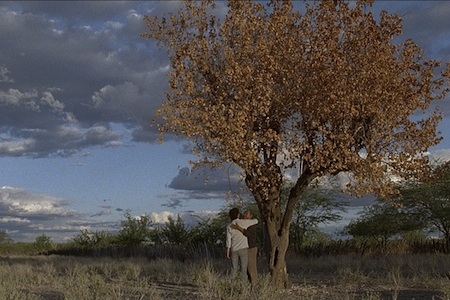
Rio de Janeiro and São Paulo have always dominated Brazil’s film industry. Films that make big splashes on the international festival circuit, City of God, Tropa de Elite, and others before them generally come from one of these hubs. Production facilities, prized vistas, and the majority of the acting talent are located there, where the telenovelas also are made. Posed to become some kind of Pollywood, Paulínia, a town outside the city of São Paulo, is home base for an industry lately churning out movies for the popcorn crowd, all of which seem to star the prodigious Selton Mello, writer, director, and protagonist of Brazil’s Oscar submission, O Palhaço (The Clown). (Mello plays the young André in Luiz Fernando Carvalho’s 2002 feature, To the Left of the Father).
But even in the silent era, several geographic “film cycles” emerged in other parts of the country. Humberto Mauro, from Minas Gerais, is the most famous example, his fiction films being among the few silent features to survive. Manaus in the Amazon, the state of Rio Grande do Sul, land of the gaucho, and Recife, capital of the northeastern state of Pernambuco, all boasted industries, albeit small, far from the urbanized south. With the Brazilian government’s sustained support of the film industry through generous tax incentives and funding opportunities available through state-run agencies, an entire new generation of filmmakers has emerged, and Brazilian cinema is again becoming as diverse as the country itself.
At this year’s Festival do Rio, two films in particular are descendants of the Recife Cycle, all tapping into the northeast’s rich history and folklore. One film is already a hot property on the international festival circuit; the other is destined for the domestic market. (A third, much older descendant, 1953’s O Canto do Mar, part of the Alberto Cavalcanti retrospective, is discussed further in a separate article on Cavalcanti.)
Gonzaga: From Father to Son, which opened the festival on September 27, is Breno Silveira’s second biographical feature based on the lives of beloved Brazilian musicians and is expected to deliver the same kind of box office as Silveiro’s 2005 smash hit, Two Sons of San Francisco, about sibling sertanejo musicians. Silveiro hails from Goiás, the state from which the federal district Brasília is carved, and was cinematographer on a number of notable Brazilian features, including the above-mentioned Carlota Joaquim, Andrucha Waddington’s Me You Them (2000), an understated comedy about a woman in the northeast backlands of Brazil living with her three husbands and infused with the lilting music of Gilberto Gil, and José Henrique Fonseca’s Man of the Year (2003), a fast-paced urban mystery-thriller shot in widescreen and in super-saturated colors.
Silveira begins his biopic of Luiz Gonzaga, the son of an accordian maker who popularized traditional northeastern music, on a shot of the cracked dry earth of the northeastern sertão, an image that has become the iconography of Brazil’s arid backlands in the way that John Ford’s shots of Monument Valley represent the American West. In his performances, Gonzaga adopted the dress of Lampião, the famous Pernambucano vigilante, immediately recognizable by his upturned leather hat, who became a Robin Hood-type folk hero in the early 20th century. The big-sky vistas in Silveiro’s films are reminiscient of the landscapes of Luiz Barreto’s O Cangaceiro (The Bandit of Brazil, 1953), about Lampião, and Glauber Rocha’s Cinema Novo films, Black God, White Devil (1964) and Antonio das Mortes (1969), about backland justice.
Gonzaga gives the Hollywood treatment to the northeasterner’s story, exploiting a familiar trope of the talented boy from nowhere with nothing but hopes and dreams who overcomes obstacles, and sustains heartaches, to finally makes it big. This story line resonates with the many Brazilian migrants who left the drought-wracked scrublands looking for prosperity in the urbanized south. Most found only a different kind of misery, in the favelas, which Silveiro gives us a small taste of in Gonzaga’s early years in Rio, busking for change on the street and marrying a dime-a-dance girl who later dies of tuberculosis.

The subtitle, “From Father to Son,” refers to Gonzaga’s firstborn, Gonzaguinha (Little Gonzaga), a composer and musician in his own right known for his protest songs during the country’s vicious military dictatorship. The tension between father and son frames the story of Gonzaga’s rise, which is ensured when he returns to his northeastern roots and records the folk tune, “Asa Branca,” turning it into a pop culture commodity and paving the way for other northeastern forms of music, like forró, to break into the mainstream.
The other festival film is already familiar to many international audiences. O Som ao Redor, directed by Kleber Mendonça Filho, garnered the FIPRESCI Prize at Rotterdam, which was an early champion of the director’s work and funded the script development of this, his first fiction feature. Released as Neighboring Sounds in the English-speaking world, it incited American critics to superlatives (“best Brazilian film since the ’70s”) when the film made its U.S. premiere last spring at New York’s New Directors/New Films series.
Set in the director’s hometown of Recife, the capital of the northeastern state of Pernambuco, the film is made on a much smaller scale than the blockbuster-style Gonzaga. Mendonça has almost all the action taking place on one city block, where one-story middle-class homes cluster at the feet of sleek, modern high-rises. The film begins, however, far from the city, with a series of black-and-white archival stills of a sugar cane plantation and its workers, the faces of these folks just one or two generations removed from the characters we are about to meet.
A taut web of interlocking stories, O Som ao Redor explores the tensions among people living on top of each other, concerned with security and other quality-of-life issues. The unease is enforced by the soundtrack, punctuated by urban noises: an incessantly barking dog, street vendor carts sporting amplified sound, screeching tires of speeding cars, the water pump, the washing machine, the television, etc. It’s not all sinister, as Mendonça has a light, humanist touch, sometimes using humor to dispel suspense.
Bia, a housewife deprived of sleep by the neighbor’s noisy weimaraner, lets the water delivery man in the house. As he goes to the kitchen to put down the heavy bottle, she furtively locks the front door. For a moment, we sense danger. Then think, is this an affair? The reason she had a hair-pulling fight with a neighbor earlier in the film? Turns out, he’s her dealer, providing the marijuana that is her only tension relief. Mendonça builds the entire film out of such suspenseful scenarios, and we never know which ones will resolve themselves harmlessly, humorously, or end in violence.
In another scene, two freelance security guards call on the man who owns most of the property they are proposing to patrol. One, who has a bum eye, is asked about his suitability for such a job. He immediately defends himself by referring to Lampião, whose own right eye was permanently blinded by an incident with a tree branch: “[He] still managed to bring down a lot of people.” Mendonça reminds us more than once that even on these modern city streets we are never far from the feudal power structure of the backlands—omnipotent colonels, exploited poor and the avenging outlaw lying in wait.
Several other notable Brazilian features have come out of this northeastern cycle in the last decade. Claudio Assis’s Mango Yellow (2002), reminscent of Caro and Jeunet’s stunning 1991 debut Delicatessen, brings together a strange bunch of locals grubbing around on society’s fringes. A public functionary uses a government-issue van to deliver purloined carcasses in exchange for a cache of weed from a burly man with a dead flesh fetish. The bar owner, who sleeps on a bed that fits exactly the dimensions of the backroom where it rests, is dog-tired of being groped, every single day, by her drunken customers. The swishy cook in love with the butcher who’s cheating on his wife, the fundamentalist Christian with a vengeful streak. All have some connection to the rundown Texas Hotel, with mold growing on the walls as garish as the characters they house. Assis skillfully weaves their destinies into a portrait of an entire underclass stranded in their stations in life.
Frequent collaborators Karim Aïnouz and Marcelo Gomes’s wonderful road movie, I Travel Because I Have to, I Come Back Because I Love You (2009), combines documentary footage with a narration by a homesick geologist surveying the backlands for a major public works project. His major concern, however, is coming to grips with his own loneliness. The audience is rarely let outside the narrator’s head, privy not only to the cataloguing of the data he collects (the kind of rock and their densities) but also his running inner monologue, one minute cursing his situation, the next relieved to be alone. “It looks like rain,” he complains, as we look out his windshield onto another cloud-laden sky, “then it never rains.” He turns the radio dial but can find nothing worth listening to. Only rarely are we let out of the intimate cocoon with the narrator: once when our geologist, now completely strayed from his assigned task, interviews a prostitute he meets at a local market and, a second time, when a leather worker takes a break to sing a folk song. (Quite possibly an obscure reference to Lampião, who grew up doing leather work on his family’s farm.)
Marcelo Gomes’s 2006 road movie Cinema, Aspirins, and Vultures (cowritten by Aïnouz) takes place during World War II in the same sun-bleached backlands. Beautifully shot in the sepia tones of the sertão, the film pairs Ranulpho, a crabby native northeasterner, with Johann, a good-natured German pacifist roaming the Brazilian countryside with his itinerant cinema, using travelogue films to sell aspirin. “Not even bombs reach here,” grouses Ranulpho to Johann, who’d rather not hear the radio reports of the distant world at war. Random hitchhikers occasionally ride along and seem to be let out in the same nowhere from which they emerged. In a small town along the way, they encounter a modern-day colonel (who, incidentally, is named Claudio Assis). Ranulpho immediately sees through the man’s thin veil of gentility, revealing his malevolence, and has a bit of nonviolent revenge with Assis’s obliging wife.
Expect to see more films with northeastern themes by northeastern directors to come out of Brazil in the future. Gomes’s latest film Once Upon a Time Was I, Veronica premiered at Toronto in September, Aïnouz is in post-production a new film, and Mendonça told me he’ll pick up work on a new script after he finishes touring with O Som ao Redor, which most recently played the London Film Festival. If Brazil continues to support its film industry in this way, fostering new talent across the country, the future may well bring many new voices from regions we’ve yet had the chance to explore.



